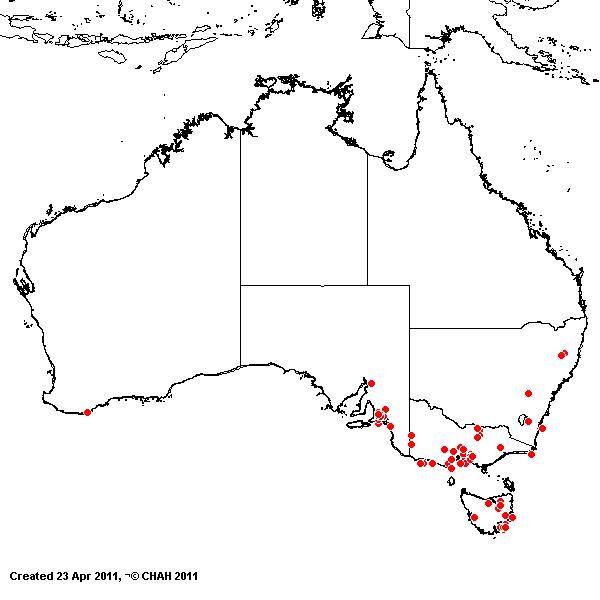Elytrigia repens* (L.) Nevski. Trudy Bot. Inst. Akad. Nauk Armjansk, SSR, ser. 1
1: 14 (1933) in adnot., fide Löve.
Classification. (GPWG 2001) : Subfamily Pooideae.
Tribe Triticeae.
Basionym and/or
Replacement Name: Triticum repens
L., Sp. Pl. 86 (1753).
Type of Basionym or
Protologue Information: LT: (LINN-104.7). LT designated by Bowden, Canad.
J. Bot. 43: 1431 (1965); cited by Assadi, Willdenowia 26: 267
(1996).
Recent synonyms:
Agropyron repens (L.) P.Beauv., A. repens var. aristata Baumg.,
Elymus repens (L.) Gould.
Key references
(books and floras): [2002] D.Sharp & B.K.Simon, AusGrass, Grasses of
Australia, [2006] J.Jessop, G.R.M.Dashorst, F.M.James, Grasses of South
Australia (267), [2008] S.W.L.Jacobs, R.D.B.Walley & D.J.B.Wheeler, Grasses
of New South Wales (238 as Elymus), [2009] A.Wilson (ed.). Flora
of Australia, Vol 44A. Poaceae 2 (101).
Illustrations:
[2006] J.Jessop, G.R.M.Dashorst, F.M.James, Grasses of South Australia (266, fig. 206), [2008] S.W.L.Jacobs,
R.D.B.Whalley & D.J.B.Wheeler, Grasses of New South Wales, 4th edn
(238 as Elymus), [2009]. A.Wilson (ed.), Flora of Australia 44A: Poaceae
2 (100, Fig.14).
Habit.
Perennial. Rhizomes present, elongated. Culms erect, 30–120 cm tall, 1–2 mm
diam., 3–5 -noded. Leaves cauline. Leaf-sheaths glabrous on surface or hairy.
Leaf-sheath auricles present. Ligule an eciliate membrane or a fringed
membrane, a ciliolate membrane, 0.3–1 mm long, hyaline or membranous, erose,
truncate. Leaf-blades flat, 6–35 cm long, 3–10 mm wide. Leaf-blade surface
smooth or scaberulous, glabrous or indumented.
Inflorescence.
Inflorescence solid, a raceme. Racemes 1, erect, 5–20 cm long.
Spikelets.
Spikelets sessile. Fertile spikelets many flowered, with at least 2 fertile
florets (3–8), comprising 3–8 fertile floret(s), with diminished florets at the
apex, elliptic to oblong, laterally compressed, 8–20 mm long.
Glumes. Glumes
similar. Lower glume lanceolate or oblong or ovate, cartilaginous or
coriaceous, without keels, 3–7 -nerved. Lower glume apex muticous or mucronate
or awned. Upper glume lanceolate, 7–12 mm long, coriaceous, without keels, 3–7
-nerved. Upper glume surface scabrous. Upper glume apex muticous to mucronate.
Florets.
Fertile lemma 8–13 mm long, without keel or keeled, 5 -nerved. Lemma apex
muticous or awned, 1 -awned. Median (principal) awn 0–10 mm long overall. Palea
2 -nerved. Lodicules present. Anthers 3. Grain 5 mm long.
Continental
Distribution: Europe, Africa, Temperate Asia, Tropical Asia, Australasia,
North America, South America, and Antarctica.
Australian
Distribution: Western Australia, South Australia, New South Wales,
Victoria, Tasmania.
Western Australia:
Menzies. South Australia: Flinders Ranges, Southern Lofty,
South-eastern. New South Wales: South Coast, Northern Tablelands,
Central Tablelands, Southern Tablelands, Central-Western Slopes, South-Western
Slopes, South-Western Plains. Victoria: East Gippsland, Gippsland Plain,
Midlands, Otway Plain, Wilsons Promontory, Riverina, Wannon. Tasmania:
No region given.
Notes.
A bad weed of cultivated land in Britain and Europe, but apparently only a
minor weed in Australia. This grass is particlularly difficult to eradicate due
to its perennation by rhizomes. As well as the production of hay, Tzvelev
(1983) recorded that this species is used as a diuretic and poultis substance.
Indigenous to Europe
and temperate Asia. Introduced to N and S America, New Zealand and all states
of Australia except Queensland and N.T. Flowers Oct.-Mar.





